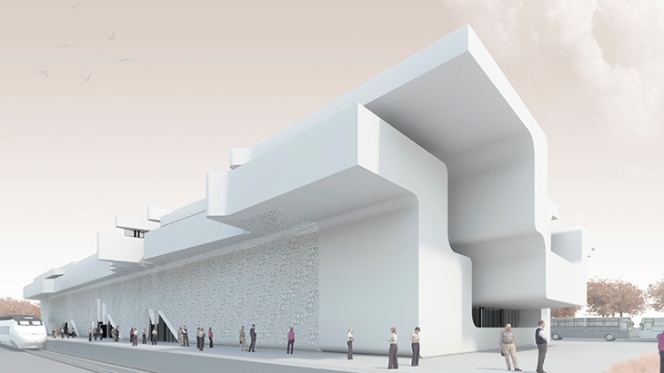Your Cart is Empty
Recent Articles
- Efficiency Meets Innovation: SketchUp 2024 Unveiled
- Maxon One Spring 2024 Release Packs Particle Power, Toon Shading, and More
- TurboCAD 2024 Unveiled by IMSI Design: Discover the New Features and Enhancements
- Exploring the Latest InfraWorks 2025 Updates
- Introducing the Latest Innovations in Autodesk's ReCap Pro 2025
- Discover the Latest Enhancements in Civil 3D 2025
- Exploring the Newest Features and Enhancements in Revit 2025
- Explore the Latest Features in Vantage 2.3 Update
- Explore the Latest AutoCAD 2025 Enhancements: Activity Insight, Smart Blocks, and Apple Silicon Support
- Unveiling Enscape 4.0: Revolutionizing Design with Unified Experience for macOS and Windows Users
The Edge: Jürgen Mayer H., Berlin’s Starchitect
March 18, 2014 5 min read

Jürgen Mayer H., photo by Paul Green
Novedge: Tell us a bit about who you are and what you do
Jürgen Mayer H.: In 1996 I founded J. MAYER H. as an interdisciplinary studio for architecture, design and communication. After studies at Stuttgart University, The Cooper Union and Princeton University, I moved to Berlin, a city transforming at full speed. Our work has been published and exhibited worldwide and is part of numerous collections including MoMA in New York and SF MoMA. National and international awards include the Mies-van-der-Rohe-Award-Emerging-Architect-Special-Mention-2003, Winner Holcim Award Bronze 2005 and Winner Audi Urban Future Award 2010. In the past years I have taught at Princeton University, University of the Arts Berlin, Harvard University, Kunsthochschule Berlin, the Architectural Association in London, the Columbia University, New York and at the University of Toronto, Canada.

Border Checkpoint, Sarpi, Georgia
Novedge: What is the vision behind J. MAYER H. und Partner, Architekten?
Jürgen Mayer H.: J. MAYER H und Partner, Architekten, focuses on works at the intersection of architecture, communication and new technology. One major investment in our work is looking at expanding the material of architecture, beyond say just building material. The influence of new media and new materials now expands our understanding of “space” as a platform for communication and sociocultural interactivity. We believe that architecture should work as an activator to move people from a passive mode of expectation to an involved level of participation and attention.
Since we always develop individual designs for specific programs, sites and clients, we don't start with a special formal attention in mind. It is developed during the design process and is influenced by former experiences for sure. Some conceptual approaches are based on our research by architectural projects and art installations. We look closely at the site, critically rethink the program and try to extract something that is special to the specific site. We establish parameters as a skeleton or framework for each project. These are conceptual conditions rather than design driven compositions, based on a clients brief, contextual references and programmatic logistics.
We want to create curiosity and surprise for the potential of a building and its context.

Railway Station, Akhalkalaki, Georgia
Novedge: You have studied and worked internationally, in Germany, the US, Canada and the UK. As architecture becomes a more and more international field, what do you see as the most exciting trends?
Jürgen Mayer H.: In 1996 I came to Berlin after graduating from Princeton and living in New York for a while, especially to confront a critical architectural education with a quite charged and vivid cultural urban condition. Parallel to establishing a practice, I started teaching, and since then teaching is a major factor in testing the architectural condensations of cultural phenomena. Competitions and smaller art installation projects became the laboratories to make certain assumptions about the production and performance of the architecture operative. We grew very gradually, and now work on a highly exciting set of projects nationally and internationally.
Social Media and digitization has definitely changed the way we produce, design, think and experience architecture. The Virtual and the material both resonate in the other and cannot be thought of independently.

FOM University, Dusseldorf, Germany
Novedge: You are based in Berlin, a city that is experiencing something of a renaissance: how does location influence your practice?
Jürgen Mayer H.: Berlin is a place where you can meet, party, work, discuss and celebrate with an incredible amount of interesting people. Berlin is a city that is shaped by many unfinished ideas about what a city should be. Berlin has been a laboratory of urban planning and architecture for more than 100 years. If there were moments when this transformation slowed down then something else opened up. Berlin is a never finished project.

Pier Sculpture, Lazika, Georgia
Novedge: Can you talk about your creative process? How do you approach each project?
Jürgen Mayer H.: We believe that architecture should work as an activator to move people from a passive mode of expectation to an involved level of participation and attention.
Since we always develop individual designs for specific programs, sites and clients, we don't start with a special formal attention in mind. It is developed during the design process and is influenced by former experiences for sure. Some conceptual approaches are based on our research by architectural projects and art installations. We look closely at the site, critically rethink the program and try to extract something that is special to the specific site. We establish parameters as a skeleton or framework for each project. These are conceptual conditions rather than design driven compositions, based on a clients brief, contextual references and programmatic logistics.
We want to create curiousity and surprise for the potential of a building and it´s context.
Novedge: What is a recent project that you worked on?
Jürgen Mayer H.: We recently had a big concentration of new works in Georgia. We finished a police station, a House of Justice and an Airport in Mestia, a new Border Checkpoint in Sarpi, three Rest Stops beside a new Highway and an iconic sculpture and pier in the Black Sea, 100 meters into the water, in the new town of Lazika. Additionally we worked on several smaller projects here like a seaside pavilion in Batumi, a private residence in Tbilisi and the President's Library in Tbilisi. Another bigger infrastructural project is the international train station in Akhalkalaki on the new train line between Aserbaidjan and Turkey. The construction works started in 2011 and will be finished at the end of this year. In the last few years, a few examples of new kinds of architecture have been appearing throughout the city – that is encouraging. We’ll have to wait and see what is still possible.
In Germany we are currently working on a new university building for FOM in Dusseldorf as well as a multi-use, high-rise project and a city block with another 100 meter high-rise.
Novedge: What software do you use?
Jürgen Mayer H.: We mostly work with ArchiCAD and for 3d with Rhino and Maya. Of course the Adobe programs and Microsoft office are used as well.

Reststops, Gori, Georgia
Novedge: What is next for you and your team?
Jürgen Mayer H.: At this point we have several projects under constructions and many more in design development. I am very curious to see how our speculations about communication and public space might transform once they are handed over and begin their own life.
Take a look at more of J. Mayer H. work on their website and connect with them on Facebook. You can also help them win this year's Architizer A+ Awards, by voting here.
And don't forget to follow Novedge on Twitter.
Related articles
Also in NOVEDGE Blog

Maxon One Spring 2024 Release Packs Particle Power, Toon Shading, and More
April 10, 2024 4 min read
Read More
TurboCAD 2024 Unveiled by IMSI Design: Discover the New Features and Enhancements
April 10, 2024 2 min read
Read MoreSubscribe
Sign up to get the latest on sales, new releases and more …




